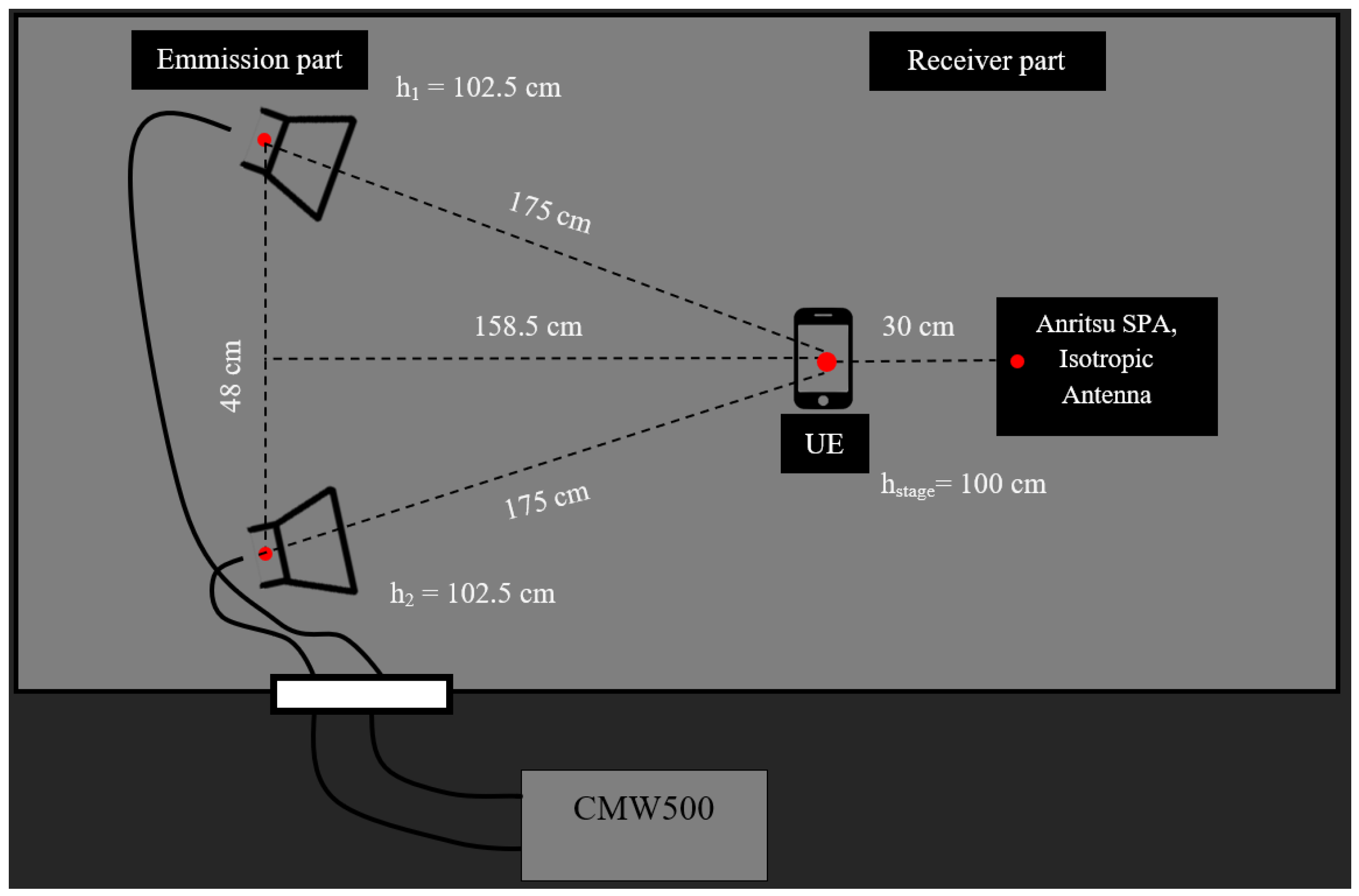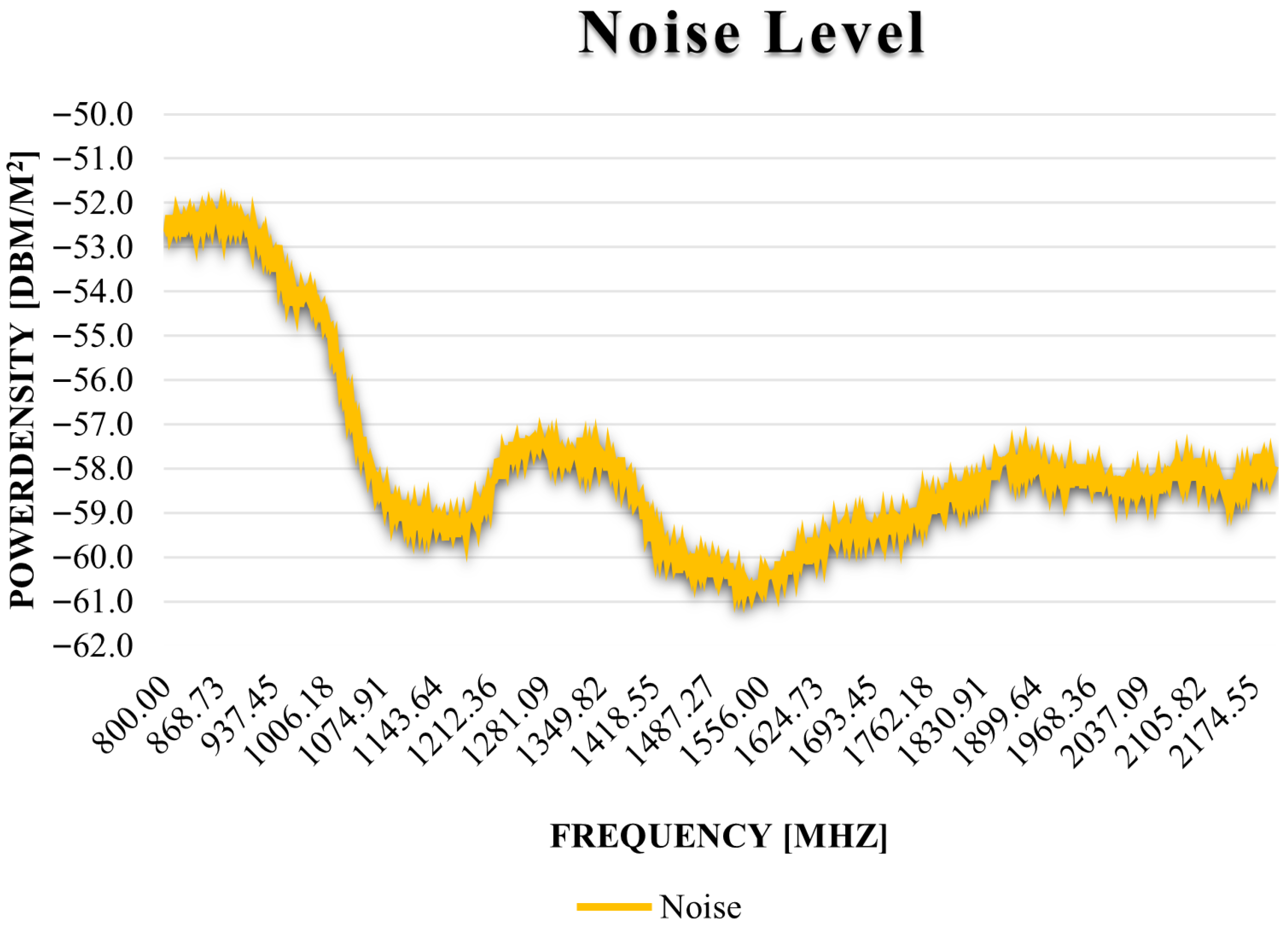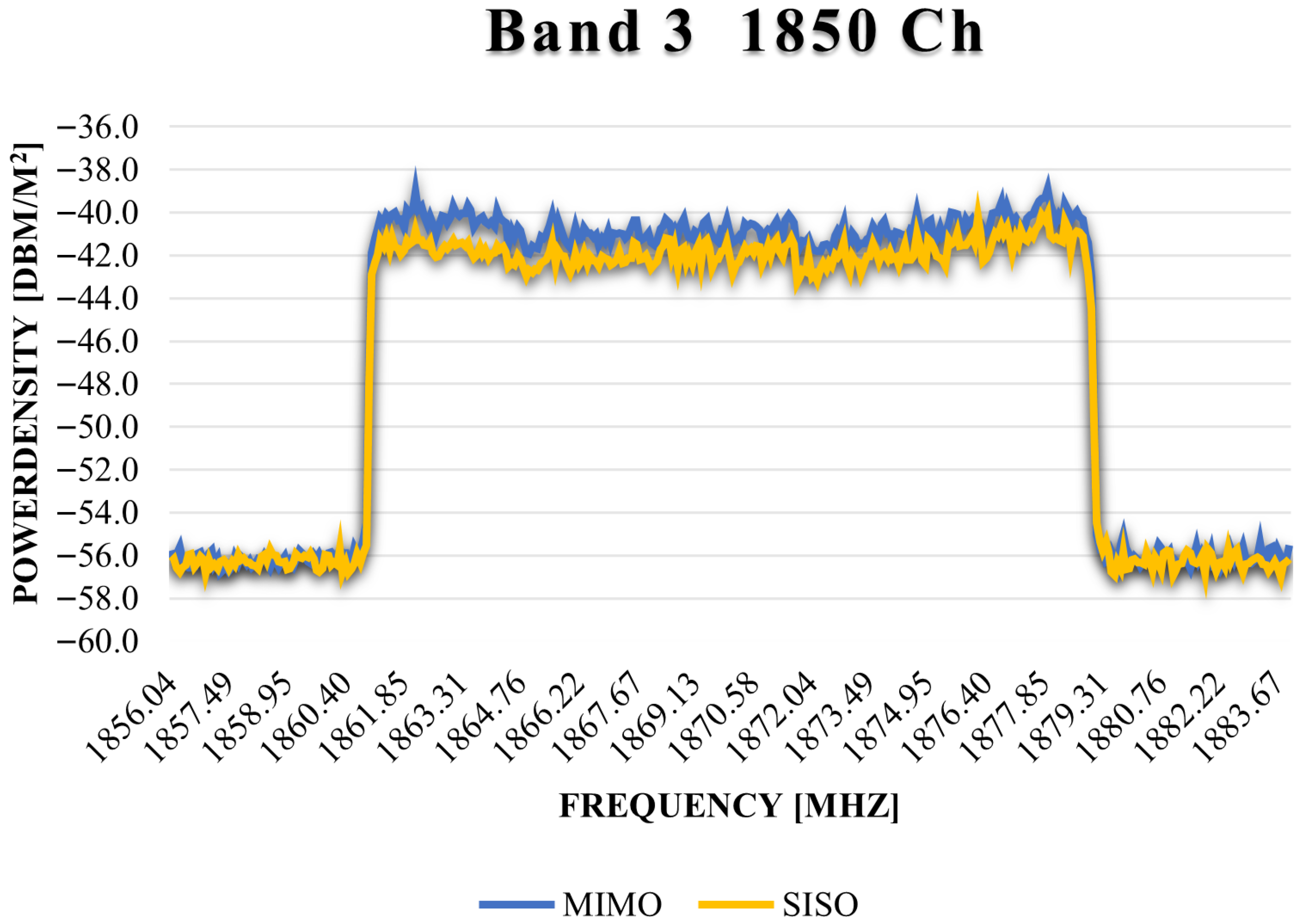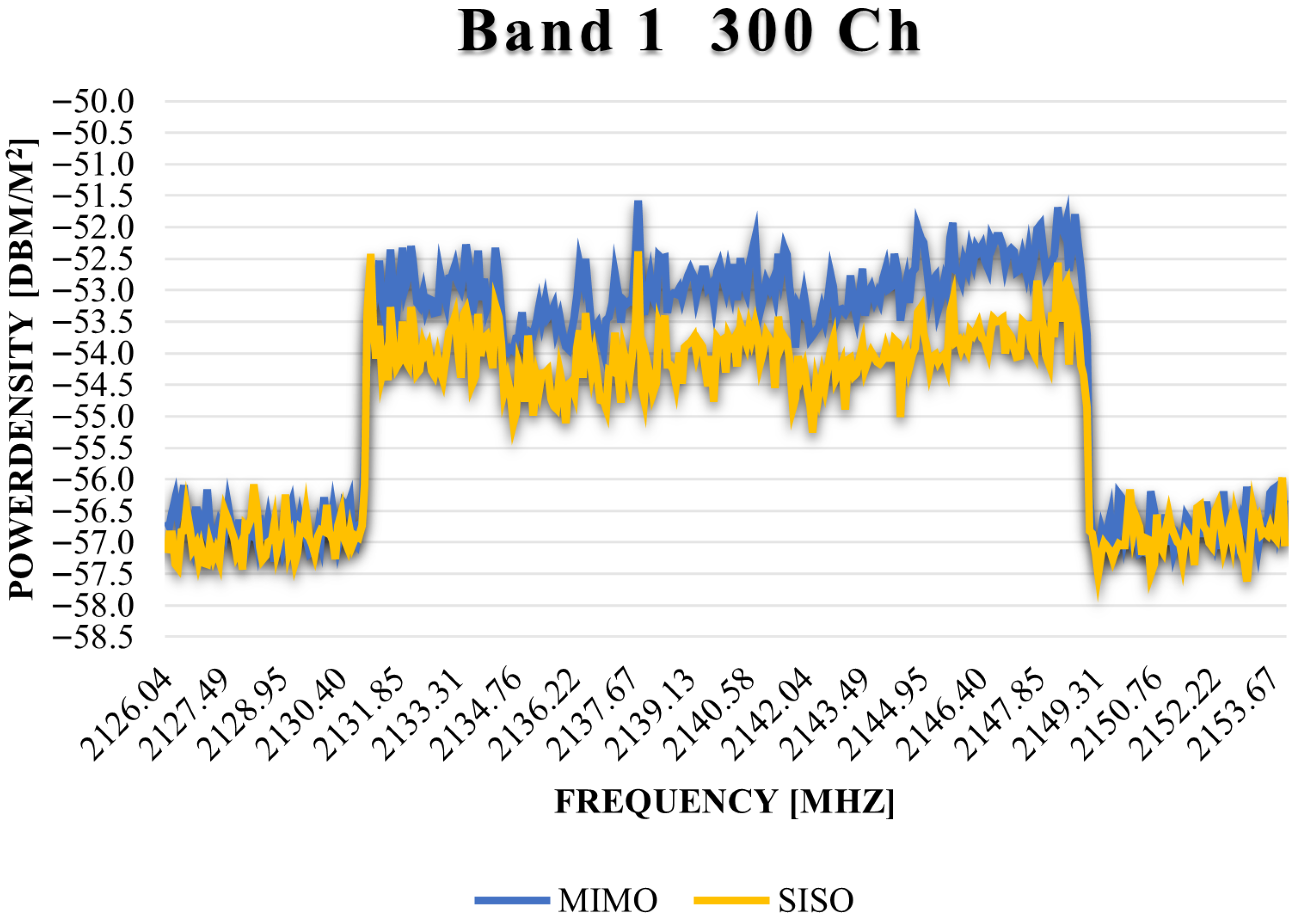1. Introduction
The reduced quality of mobile service channels observed toward the edges of cells stems from the degradation of radio parameters in cellular systems. In a traditional cellular architecture, one or more antennas of the base station are located at the center of the cell [
1]. As the power of electromagnetic waves decreases quadratic with propagation distance due to free-space path loss, the signal received by user equipment (UE) located farther from the base station becomes significantly attenuated. Concurrently, the signal-to-interference-plus-noise ratio (SINR) declines, leading to a continuous reduction in the spectral efficiency. This problem becomes particularly significant near cell edges, especially when operating in higher frequency bands such as 2 GHz, where shorter wavelengths result in increased path loss [
2,
3].
In recent years, the emergence of new-generation antenna systems—referred to in the literature as active or massive antenna systems—has opened new possibilities for addressing this issue. The antenna elements of an active antenna system can be controlled with highly complex configuration options, allowing for various radio techniques to improve the radio conditions in a given area and thereby enhance connection quality. Notable techniques include beamsweeping, beamforming, interference suppression, and spatial multiplexing. While the first three methods improve spectral efficiency by enhancing radio parameters such as reference signal received power (RSRP) and SINR, spatial multiplexing achieves this through the use of different coding schemes under given radio quality conditions. As a result, cellular systems can enhance spectral efficiency in multiple ways through the application of MIMO (Multiple Input Multiple Output) technology [
4,
5].
However, MIMO technology also presents limitations, as the same frequency and time domain can be shared by multiple users, necessitating proper separation between users. This becomes especially problematic as distance from the base station increases, since lower SINR values make it more difficult to separate and decode parallel data streams in spatial multiplexing. If coverage continues to degrade, the system switches to a lower-frequency channel, which provides greater coverage but lower capacity. In such cases, communication continues in SISO mode, and the network makes no attempt to reactivate MIMO.
The emergence of high-element-count antenna systems introduces the so-called massive MIMO technology, which significantly increases MIMO capacity by serving more users with higher layer counts. In such systems, MIMO is interpreted separately for each formed radiation beam. The directional capabilities enabled by beamforming also have a positive effect on user separation and help mitigate the aforementioned SINR issues. This allows higher capacity and connection quality to be maintained over a broader area [
6,
7,
8].
Currently, these high-element-count massive antenna systems are primarily available in the 3.5 GHz and 26 GHz frequency bands used by 5G technology [
9,
10]. However, as of 2025, midband active antenna systems have also appeared, designed to operate in the 1.8–2.6 GHz frequency range [
11]. This frequency band is currently used mainly by LTE technology. According to recent research, lowband active antenna systems—designed for 700–900 MHz bands—will also soon become available for cell deployment [
12]. In fact, 5G services are already being deployed in this lower-frequency range to ensure indoor coverage. The emergence of these antenna systems is especially important, as a decrease in frequency range is accompanied by a reduction in free-space attenuation. Consequently, the capacity of midband and lowband cells using the new systems increases significantly, allowing networks to provide higher quality and capacity over larger areas [
13].
The goal of this research is to develop a measurement method capable of reliably and accurately assessing electromagnetic power density in the downlink direction for both MIMO and SISO systems. Using the developed examination procedure, it is confirmed that MIMO technology—including massive MIMO—does not inherently increase electromagnetic exposure due to the nature of the technology itself. Furthermore, the application of massive MIMO in the lowband enables the network to provide the same coverage and average user capacity at a lower electromagnetic power density compared to higher bands [
14,
15,
16,
17]. This in turn may reduce the level of electromagnetic exposure experienced by the human body. However, it is important to note that this work does not include an analysis of specific absorption rate (SAR) or the effects of distributed MIMO configurations. These aspects are beyond the scope of the present study and are therefore acknowledged as limitations.
The article is organized the following way. In
Section 2, an overview of EMF exposure assessment in MIMO systems is given. In
Section 3, we give the proposed measurement setup, including the equipment, configurations, and methods. Next, in
Section 4, the measurement results are presented, while the last section draws the conclusion.
Author Contributions
Conceptualization, methodology, investigation, resources, K.M. and P.P.; software, validation, K.M.; writing—original draft preparation, K.M., P.P. and S.N.; writing—review and editing, K.M., S.N.; visualization, K.M. and S.N.; supervision, P.P. and S.N.; project administration, P.P. All authors have read and agreed to the published version of the manuscript.
Funding
This research received no external funding.
Informed Consent Statement
Not applicable.
Data Availability Statement
The original contributions presented in this study are included in the article. Further inquiries can be directed to the corresponding author.
Acknowledgments
Supported by the EKÖP-24-3-I University Research Fellowship Program of the Ministry for Culture and Innovation from the source of the National Research, Development and Innovation Fund.
Conflicts of Interest
The authors declare no conflicts of interest.
Abbreviations
The following abbreviations are used in this manuscript:
| 3GPP | Third-Generation Partnership Project |
| 5G | Fifth Generation of Wireless Cellular Technology |
| BLER | Block Error Rate |
| CC | Component Carrier |
| CSI-RS | Channel State Information Reference Signal |
| DCI | Downlink Control Information |
| DL | Downlink |
| EMF | Electromagnetic Field |
| eNodeB | evolved Node B |
| FCBP | Full Cell Bandwidth Power |
| ICNIRP | International Commission on Non-Ionizing Radiation Protection |
| LTE | Long Term Evolution |
| Massive MIMO | Massive Multiple Input Multiple Output |
| MIMO | Multiple Input Multiple Output |
| OL | Open-loop |
| PCC | Primary Component Carrier |
| PDCCH | Physical Downlink Control Channel |
| QAM | Quadrature Amplitude Modulation |
| QPSK | Quadrature Phase Shift Keying |
| RE | Resource Element |
| RS EPRE | Reference Signals Energy Per Resource Element |
| RSRP | Reference Signal Received Power |
| RSSI | Received Signal Strength Indicator |
| RX | Receive |
| SINR | Signal-to-Interference-plus-Noise Ratio |
| SISO | Single Input Single Output |
| SSB | Synchronization Signal Block |
| TS | Technical Specification |
| UE | User Equipment |
| UL | Uplink |
References
- You, X.; Wang, D.; Zhu, P.; Sheng, B. Cell edge performance of cellular mobile systems. IEEE J. Sel. Areas Commun. 2011, 29, 1139–1150. [Google Scholar] [CrossRef]
- Li, X.; He, C.; Zhang, J. Spectral efficiency and energy efficiency of bidirectional distributed antenna systems with user centric virtual cells. IEEE Access 2018, 6, 49886–49895. [Google Scholar] [CrossRef]
- Molisch, A.F. Wireless Communications: Second Edition; Wiley-IEEE Press: Chichester, UK, 2011. [Google Scholar]
- Andrews, J.G.; Buzzi, S.; Choi, W.; Hanly, S.V.; Lozano, A.; Soong, A.C.; Zhang, J.C. What will 5G be? IEEE J. Sel. Areas Commun. 2014, 32, 1065–1082. [Google Scholar] [CrossRef]
- Chih-Lin, I.; Rowell, C.; Han, S.; Xu, Z.; Li, G.; Pan, Z. Toward green and soft: A 5G perspective. IEEE Commun. Mag. 2014, 52, 66–73. [Google Scholar] [CrossRef]
- Björnson, E.; Hoydis, J.; Sanguinetti, L. Massive MIMO networks: Spectral, energy, and hardware efficiency. Found. Trends® Signal Process. 2017, 11, 154–655. [Google Scholar] [CrossRef]
- Hassan, N.; Fernando, X. Massive MIMO wireless networks: An overview. Electronics 2017, 6, 63. [Google Scholar] [CrossRef]
- Larsson, E.G. Fundamentals of Massive MIMO; Cambridge University Press: Cambridge, UK, 2015. [Google Scholar] [CrossRef]
- Zeng, S.; Di, B.; Zhang, H.; Gao, J.; Yue, S.; Hu, X.; Fu, R.; Zhou, J.; Liu, X.; Zhang, H.; et al. RIS-Based IMT-2030 Testbed for MmWave Multi-Stream Ultra-Massive MIMO Communications. IEEE Wirel. Commun. 2024, 31, 375–382. [Google Scholar] [CrossRef]
- el Mrini, M.; Mchbal, A.; Touhami, N. Design of a 240 elements antenna system for 5G massive MIMO applications with an inclined beam and two operating modes. J. Electromagn. Waves Appl. 2024, 38, 1796–1810. [Google Scholar] [CrossRef]
- Huawei Technologies Co., Ltd. Huawei Launches Industry’s First FDD Tri-Band Massive MIMO; Huawei Technologies Co., Ltd.: Shenzhen, China, 2025. [Google Scholar]
- Abdalmalak, K.A.; Yousfi, A.E.; Vargas, D.S. Massive MIMO Antenna Arrays for Low-Frequency Bands. In Innovation in MIMO Systems [Working Title]; IntechOpen: London, UK, 2024. [Google Scholar] [CrossRef]
- Bogale, T.E.; Le, L.B. Massive MIMO and mmWave for 5G Wireless HetNet: Potential Benefits and Challenges. IEEE Veh. Technol. Mag. 2016, 11, 64–75. [Google Scholar] [CrossRef]
- Wang, H.; Xu, L.; Yan, Z.; Gulliver, T.A. Low-Complexity MIMO-FBMC Sparse Channel Parameter Estimation for Industrial Big Data Communications. IEEE Trans. Ind. Inform. 2021, 17, 3422–3430. [Google Scholar] [CrossRef]
- Pu, X.; Sun, Z.; Chen, Q.; Jin, S. Low-Complex Channel Estimation in Extra-Large Scale MIMO with the Spherical Wave Properties. Phys. Commun. 2023, 61, 102208. [Google Scholar] [CrossRef]
- Chen, A.; Xu, W.; Lu, L.; Wang, Y.; Wang, X.; Chau, Y.; He, M. Sparsity-Based Channel Estimation Exploiting Deep Unrolling for Downlink Massive MIMO. In Proceedings of the IEEE Global Communications Conference (GLOBECOM), Kuala Lumpur, Malaysia, 4–8 December 2023; pp. 1507–1512. [Google Scholar] [CrossRef]
- Li, W.; Lin, Z.; Guo, Q.; Vucetic, B. Exploiting Structured Sparsity with Low Complexity Sparse Bayesian Learning for RIS-assisted MIMO mmWave Channel Estimation. IEEE Trans. Veh. Technol. 2023, 73, 6752–6764. [Google Scholar] [CrossRef]
- Expósito, I.; Hakizimali, C.; Sánchez, M.G.; Cuiñas, I.; Verhaevert, J. Human exposure to EMF from 5G base stations: Analysis, evaluation and comparison of different assessment methods. Measurement 2024, 229, 114434. [Google Scholar] [CrossRef]
- Korkmaz, E.; Aerts, S.; Coesoij, R.; Bhatt, C.R.; Velghe, M.; Colussi, L.; Land, D.; Petroulakis, N.; Spirito, M.; Bolte, J. A comprehensive review of 5G NR RF-EMF exposure assessment technologies: Fundamentals, advancements, challenges, niches, and implications. Environ. Res. 2024, 260, 119524. [Google Scholar] [CrossRef]
- ETSI TS 136 104 V14.3.0; Evolved Universal Terrestrial Radio Access (E-UTRA), Base Station (BS) Radio Transmission and Reception. European Telecommunications Standards Institute: Sophia Antipolis, France, 2017.
- Ziegelberger, G. ICNIRP statement on the “guidelines for limiting exposure to time-varying electric, magnetic, and electromagnetic fields (UP to 300 GHz)”. Health Phys. 2009, 97, 257–258. [Google Scholar] [CrossRef]
- Ziegelberger, G.; Croft, R.; Feychting, M.; Green, A.C.; Hirata, A.; d’Inzeo, G.; Jokela, K.; Loughran, S.; Marino, C.; Miller, S.; et al. Guidelines for Limiting Exposure to Electromagnetic Fields (100 kHz to 300 GHz). Health Phys. 2020, 118, 483–524. [Google Scholar] [CrossRef]
- ETSI TS 138 306 V16.3.0; User Equipment (UE) Radio Access Capabilities (Release 16). European Telecommunications Standards Institute: Sophia Antipolis, France, 2021.
- Velghe, M.; Aerts, S.; Martens, L.; Joseph, W.; Thielens, A. Protocol for personal RF-EMF exposure measurement studies in 5th generation telecommunication networks. Environ. Health 2021, 20, 36. [Google Scholar] [CrossRef]
- Borges, D.; Montezuma, P.; Dinis, R.; Beko, M. Massive MIMO techniques for 5G and beyond—Opportunities and challenges. Electronics 2021, 10, 1667. [Google Scholar] [CrossRef]
- Ibrahim, S.K.; Singh, M.J.; Al-Bawri, S.S.; Ibrahim, H.H.; Islam, M.T.; Islam, M.S.; Alzamil, A.; Abdulkawi, W.M. Design, Challenges and Developments for 5G Massive MIMO Antenna Systems at Sub 6-GHz Band: A Review. Nanomaterials 2023, 13, 520. [Google Scholar] [CrossRef]
- Giordani, M.; Polese, M.; Roy, A.; Castor, D.; Zorzi, M. A tutorial on beam management for 3GPP NR at mmWave frequencies. IEEE Commun. Surv. Tutor. 2019, 21, 173–196. [Google Scholar] [CrossRef]
- Rappaport, T.S.; Xing, Y.; MacCartney, G.R.; Molisch, A.F.; Mellios, E.; Zhang, J. Overview of Millimeter Wave Communications for Fifth-Generation (5G) Wireless Networks-With a Focus on Propagation Models. IEEE Trans. Antennas Propag. 2017, 65, 6213–6230. [Google Scholar] [CrossRef]
- Petzold, J.; Magdowski, M.; Vick, R. Investigation of the Impact of Height Scans in Fully Anechoic Rooms on Detection of Maximal Radiated Field Strength Using Monte Carlo Simulation. In Proceedings of the IEEE International Symposium on Electromagnetic Compatibility, Gothenburg, Sweden, 5–8 September 2022. [Google Scholar] [CrossRef]
- 3GPP TR 36.873 V12.7.0; Technical Specification Group; Radio Access Network; Study on 3D Channel Model for LTE (Release 12). 3rd ed. Generation Partnership Project: Sophia Antipolis, France, 2017.
- ETS-Lindgren. 3115 Double-Ridged Guide Antenna: Datasheet; ETS-Lindgren: Cedar Park, TX, USA, 2012. [Google Scholar]
- ETSI TR 100 028-1 V1.4.1; Electromagnetic Compatibility and Radio Spectrum Matters (ERM), Uncertainties in the Measurement of Mobile Radio Equipment Characteristics; Part 1. European Telecommunications Standards Institute: Sophia Antipolis, France, 2001.
- ETSI TR 100 028-2 V1.3.1; Electromagnetic Compatibility and Radio Spectrum Matters (ERM), Uncertainties in the Measurement of Mobile Radio Equipment Characteristics; Part 2. European Telecommunications Standards Institute: Sophia Antipolis, France, 2001.
- Rohde and Schwarz. R&S®CMW Wideband Radio Communication Tester Specifications R&S®CMW500, R&S®CMW290, R&S®CMW270; Rohde & Schwarz GmbH & Co. KG: Munich, Germany, 2018. [Google Scholar]
- Anritsu. 2000–1791–R Isotropic Antennas Technical Data Sheet; Anritsu Corporation: Kanagawa, Japan, 2024. [Google Scholar]
- Anritsu. MS2720T Spectrum Master™ High Performance Handheld Spectrum Analyzer Spectrum Master Technical Data Sheet; Anritsu Corporation: Kanagawa, Japan, 2024; Technical Report. [Google Scholar]
- Rohde & Schwarz. R&S CMW500 Wideband Radio Communication Tester: User Manual (Version 3.0.14); Rohde & Schwarz GmbH & Co. KG: Munich, Germany, 2012. [Google Scholar]
- Rohde & Schwarz. LTE RF Measurements with the R&S CMW500 According to 3GPP TS 36.521-1 Application Note; Rohde & Schwarz GmbH & Co. KG: Munich, Germany, 2014. [Google Scholar]
- Rappaport, T. Wireless Communications, Principles and Practice; Prentice Hall: Upper Saddle River, NJ, USA, 2002. [Google Scholar]
- Federal Communications Commission. Samsung Galaxy S21 5G SAR Test Report Part 1 and Antenna Information, FCC ID, A3LSMG991U; HCT Co Ltd.: Icheon, Republic of Korea, 2021. [Google Scholar]
- ETSI TS 136 133 V16.7.0; Evolved Universal Terrestrial Radio Access (E-UTRA), Requirements for Support of Radio Resource Management. European Telecommunications Standards Institute: Sophia Antipolis, France, 2020.
- Anritsu. Programming Manual Spectrum Master MS2720T High Performance Handheld Spectrum Analyzer; Anritsu Corporation: Kanagawa, Japan, 2023. [Google Scholar]
- ETSI EN 301 908-13 V13.2.0; IMT Cellular Networks; Harmonised Standard for Access to Radio Spectrum; Part 13: Evolved Universal Terrestrial Radio Access (E-UTRA) User Equipment (UE). European Telecommunications Standards Institute: Sophia Antipolis, France, 2021.
- IEC 62232; Determination of RF Field Strength, Power Density and SAR in the Vicinity of Radiocommunication Base Stations for the Purpose of Evaluating Human Exposure. International Electrotechnical Commission: Geneva, Switzerland, 2022.
- Federal Communications Commission. Household Broadband Guide; Federal Communications Commission: Washington, DC, USA, 2022. [Google Scholar]
- ETSI TS 136 213 V16.2.0; Evolved Universal Terrestrial Radio Access (E-UTRA), Physical Layer Procedures (Release 16). European Telecommunications Standards Institute: Sophia Antipolis, France, 2020.
- ETSI TS 136 214 V14.2.0; Evolved Universal Terrestrial Radio Access (E-UTRA), Physical Layer, Measurements (Release 14). European Telecommunications Standards Institute: Sophia Antipolis, France, 2017.
| Disclaimer/Publisher’s Note: The statements, opinions and data contained in all publications are solely those of the individual author(s) and contributor(s) and not of MDPI and/or the editor(s). MDPI and/or the editor(s) disclaim responsibility for any injury to people or property resulting from any ideas, methods, instructions or products referred to in the content. |
© 2025 by the authors. Licensee MDPI, Basel, Switzerland. This article is an open access article distributed under the terms and conditions of the Creative Commons Attribution (CC BY) license (https://creativecommons.org/licenses/by/4.0/).













